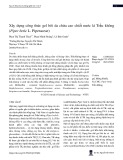
Vol. 7, 2020
A new decade
for social changes
www.techniumscience.com
9 772668 779000
ISSN 2668-7798

The Psycho-biophysical Modeling of the some Stress
Parameters
Janos Vincze, Gabriella Vincze-Tiszay
Health Human International Enviroment Foundation, Budapest, Hungary
ndp@t-online.hu
Abstract. The human organism is a biophysical system. Stress represents a normal reaction of
the organism which appears as a response to an aggression situation which requires an unusual
and quick adaptation effort from the organism. Stress is a state of putting in alert, of mobilizing
the forces of the organism in the occasion of an event which requires, in order to be kept under
control, a big amount of energy in a very short time. This alert state or action preparation
translated through physical and psychological manifestations. In higher-level living organisms
the following forms of regulation are known: biological, nervous, hormonal, humoral and
immune regulation. In the case of humans, psychic regulation also appears due to the existence
of psychic activity. We study only two forms of the stress: fear and death. We present different
biophysical modeling aspects. The stress in the human organism is a perturbation. This
perturbation is regulates by negative feedback.
Keywords. stress, psycho-biophysical modeling, negative feedback, fear, death
The Biopsychical system
„Mens sana in corpore sano” – that is „a sound mind in a sound body” points to the inseparable
unity of the biological and psychical nature of the man. Neither of them can subsist without the
other. The psychic events, however, may be incomprehensible as they are, the organic substrate
of these are provided by our individual biological structure. Thus the unity is composed of two
parts: as separated they operate independently but they mutually determine the functionality of
each other. If a function of a so balanced system breaks down it will burden the function of the
connected organs which brings about disfunction in the organ itself as well as in the organism
and these will react on each other. Anorexia and bulimia, e.g., both are based on psychical
motives asserted themselves in somatic relation: the uncontrolled hunger and the nerve-centre
(knot, ganglion) responsible for saturation-feeling generate organic injuries.
In this biopsychical system [1] there are, from the biophysical point of view, psychosomatic
and somatopsychic, i.e. psychic alterations elicited by organic disfunction like renal diseases,
brain tumour, gastric ulcer, etc. with their psychic alterations as concomitant signs. The
emotional stress results in anguish having vegetative concomitants as sweating, change of
temperature, flush-paleness, retching (nausea), flux (diarrhoea), micturition, etc. By recurrence
of such vegetative phenomena organic changes can come into being. This is called
psychosomatic symptom formation. [2]
201
Technium Social Sciences Journal
Vol. 7, 201-208, May 2020
ISSN: 2668-7798
www.techniumscience.com

The psychical emotion may influence also the effect of some hormones not only the function
of some organs. The significant part of the psychosomatic disturbances is such reaction which
exists also in normal state but it gets longer in time and its intensity increases. The repeated
stimulus-answer reaction effects after a while from a quantitative to qualitative jump creating
temporary or irreversible changes of lesser-greater extent. A stage of eternal rotation takes place
in the closed system claimed to external intervention because of the balancing role of the
homeostasis has got loosed. On the ground of all these, different arrangements can be pointed
out: primary and secondary cause and effect, resp. or the symptom of neurotic or organic
process resulting from endogenous or exogenous effect the inner pathomechanism of which one
must intervene.
General view about the stress
The present approach is intended to submit a surway and at the same time a perspective for
future research in the topic of stress.
The stress response is an essential component of the body’s regulatory systems. Stress is
nowadays a reality of the contemporary life which implies as well various categories of society
as the entire population. [3]
The causes of this phenomenon are multiple:
– high incidence of stress symptoms;
– negative outcomes for health with increased morbidity and even cardiovascular or psychiatric
mortality;
– pressure of the mass-media publicity offering many kind of medication proposed by
traditional and complementary medicine.
During about fifty years we enjoyed the collaboration of many researchers apart physiology;
psychologists, biologists, clinicians – therefore several of our papers have a multi or
interdisciplinary nature. Our studies concerned particularly the exercise stress, investigated in
the laboratory or in field conditions as well in animal as in human subjects, inclusively on
athletes.
In the last decades the stress concept shifted from the biological doctrine founded by Selye to
an integrative psychobiological theory, associated to a biopsychosocial model. Contemporary
neuroscience, cognitive psychology and psychosomatics made major contributions to the
elaboration of this construct. According to the interactive, transactional concept of stress it
depends on the individual capacities to perceive adverse factors and on the cognitive evaluation
of the relations between the subject and the physical and social environment. The psycho-
biological and behavioral reactions to stressful events are therefore dependent on the
balance/unbalance between the coping resources of the subject and his capacities to design
strategies to lessen or avoid stress. [4]
Well known is the Cannon's notion of homeostasis – maintenance of constant or appropriate
internal conditions and functioning in changing environmental demands. In contrast to
homeostatic systems such as blood oxygen, blood pH, and body temperature allostatic
adaptative systems have much broader boundaries. They enable to respond to our physiological
states (e. g. awake, asleep, supine, standing, exercising, isolation, hunger, extremes of
temperatures, danger, microbial infections). Allostasis is defined „as the organism’s ability to
active stabilizing through changing by expending energy toward challenges”. „Allostatic load”
is the cumulative cost of the organism on going to repeated cycles of adaptation, a long-term
effect of the physiological response to stress with possible adverse outcomes on various systems
leading to disease. Examples of allostatic load are the adverse effects of job strain on the
cardiovascular system and the inhibition of cellular immunity resulting from chronic stress.
202
Technium Social Sciences Journal
Vol. 7, 201-208, May 2020
ISSN: 2668-7798
www.techniumscience.com

„Allostatic support” refers to mechanisms that confer resistance to individuals making them
more robust to PTSD, other kinds of stress and chronic illnesses. [5]
Moderators which influence long-term effects of stress.
– Coping – volitional management of stressful events and regulation of the reponses to stress.
– Resilience – related as well to cellular processes that protect cells and tissues against allostatic
load as to psychological resistance.
– Hostility – a psychosocial variable mostly associated with higher incidence of CHD.
Fear and Anguish
Fear and is a regressive attitude of the bio-psychical system because with its accomplishment
the self-control becomes weaker, informations from the environment (objective circumstance)
as well as their treatment (subjective circumstance) become unreal appearance. Fear can happen
under the influence of unconditional stimulus and on its recurrence or from some kind of
reasoned situation as an information from previous experience. The more intelligent the person
becomes the better he can distinguish between the real motive producing fear and the casual
unknown. [6]
Let’s list some few of the numerous types of fear. The material fear is attached to a definite
thing (needle, fire, etc.) or occurrence (lightning, thunder, deep water, altitude, etc.) which can
be essentially decreased by recognition, awareness and practical adaptation of the casual link.
The symbolic fear has no concrete objective linkage but bound to an abstracted idea (nightmare,
ghost, hell, witch) which can show decreasing tendency through enlarging the attained
knowledges and their interference with the reality.
The separative fear is the person’s own induced state that rises in it probably related to the
negative reaction of the environment. We speak about isolational fear when the person shall
effectively be frustrated by the society, excluded from one or more forms of the social activity
(unemployment, prison, familiar loneliness, uncurable disease, etc.) The general fear is already
not an actual state but permanent defending mechanism of the personality and unsuccesful
(self~)defense to the environmental stimuli, response reaction to stressors, respectively. The
general fear from punishment („the ignorance of the law excuses no man from the punishment”)
from which it follows that man undergoes fear having been endangered in the communal life,
in the society, in every life situation. In consequence of this continuously many thousand times
repeating state he comes so far to antecipate the fiasco of his activity, the unavoidable failures
provoking distorted, incorrect interpretations from his environment, sustaining personal injury.
The multiple relived failure experiences may bring about permanent change of the personality,
create panic reaction in the course of decision dilemmas, so to say short-circuit actions.
It is difficult to differentiate between the fears of a healthy man and that of a patient because
you hardly can take the measure of the circumstances of their subjective treatment, of the
injuries accumulated before, of their intimate condition. Depending on the appearance, fear can
be categorized according to exteriorized behaviour (emotional manifestation, depression,
tension) and organic symptoms (dry throat, slow breathing, anxiety, weakness, retching,
sweating, giddiness, etc.).
The state of anguish in the bio-psychical system can come about as accumulated previous
experiences the aetiology of which, however, might have been considered easy, one cannot
determine it unambiguously. According to Freud, it is an inner notice of the man to prepare the
personality to take precautions for a future situation. With any person, the activity form to come
may induce tension-anguish. The nurturing-education of man and his previous knowledges
decide whether he will be followed by positive or negative anguish in his future activities. In
203
Technium Social Sciences Journal
Vol. 7, 201-208, May 2020
ISSN: 2668-7798
www.techniumscience.com

the well balanced man the positive anguish predominates even in the case if he has to carry out
in the future such activity where his preliminary experiences are minimal or unadequate.
The anguish very often acts as hindrance which can considered normal (exam, stage
appearance) and is typical for every person. The anguish turns into abnormal if it is shifted
towards future activity and only the tension remains which in this way won’t be bound to
concrete action, and by dominating ever longer period, it becomes a psychical pathology.
Anguish is after all a fearful disposition through which it turns into fear without reason and
content. This state is reflected by the very true name hovering, as a matter of fact the person is
living, namely, in hesitation.
The symptoms of anguish are: behavioural (negativism, unquietness, aggressivity, difficulty in
accomodation), affective (lability, sensibility, phantom dream, startledness), somatic
(headache, giddiness, vomiting, anorexy).
These regressive defense mechanisms are enlarging the clinical picture when also the emotional
co-efficient appears, i.e. the emotion-based manifestation is associated with the behavioural
component. The projected feeling of the anguish results troubles in conduct and serves primary
reason for avoid failure, so every experience receives traumatic complexion. Just for this it is
necessary to reduce the period of the anxious state in the evolution of the personality and that
in the adult man to a minimum ; in its implementation immense responsibility rests upon the
society, the laws and public functionaries (government officials) representing all those bodies
the citizen gets in touch.
The relationship of life and death
Death shouldn’t be contrasted to life but with the living capacity. The limited, irrevocable
cessation of life cannot be reversed. It is the disintegration of that order according to which the
parts in the living organism are working. This order won’t be upset by freeze-drying, the process
will stop only, but under more favourable conditions they can operate again co-ordinated. It is
not even sure that by death these processes shall halt. Parts can work further just the harmony
between them shall stop irrevocable, the co-operative order shall overturn irreversibly. [6]
Everybody comes into the world with some hereditary adaptive energy taken from the
ancestors, parents. He may use it for a long life time with careful thrift or consume run through
during a short period with a conduct full of stresses. The inherited quantity of energy is given
but the rhythm of consumption shall be determined mainly by ourselves.
Death is the last symptom of life for every living organism. Its cause can be some outer effect
(e.g. sickness), but the organism can perish without any outer cause, also as a result of inner
causes, this being the so-called „natural” death. Inner causes should be found among the most
essential living symptoms, in the metabolism. On its course more and more cells get destroyed
and also the remainder, those who survive shall change disadvantageously. Natural death is
frequent in low-grade animals, in higher grade we meet predominantly pathological death.
„Natural” death has not been observed with man. Aging was never found to be the direct cause
of death. Should anybody die of old age it would mean that all his organs would have been
equally used up during the long activity. But without any exception everybody dies in a manner
that a certain organ as compared with the others is disproportionately used up. The life keeping
our organs together can be compared with a chain the durability of which depends upon the
weakest link of the chain. Independently how important it is, if getting broken our organs can
no longer unite to a living body.
204
Technium Social Sciences Journal
Vol. 7, 201-208, May 2020
ISSN: 2668-7798
www.techniumscience.com


















![Hướng dẫn giải chi tiết bài tập phân li, phân li độc lập: Tài liệu [mới nhất]](https://cdn.tailieu.vn/images/document/thumbnail/2025/20251204/lethu2868@gmail.com/135x160/84711764814448.jpg)



![Bài tập Đa dạng thế giới sống [kèm đáp án/ hướng dẫn giải]](https://cdn.tailieu.vn/images/document/thumbnail/2025/20251123/thaohoang9203@gmail.com/135x160/5861763951302.jpg)



